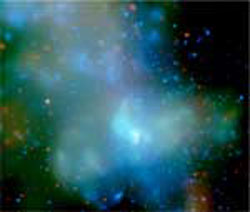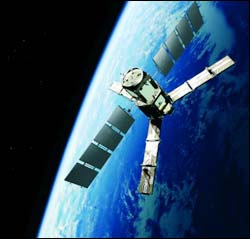This area deals with the fundamental laws and building blocks of nature and how they interact, the properties and the behavior of matter, and research into space and time and their structures.
innovations-report provides in-depth reports and articles on subjects such as astrophysics, laser technologies, nuclear, quantum, particle and solid-state physics, nanotechnologies, planetary research and findings (Mars, Venus) and developments related to the Hubble Telescope.

For the past several years, a team of University of California astrophysicists working at Los Alamos National Laboratory have been using a cluster of roughly 300 computer processors to model some of the most intriguing aspects of the Universe. Called the Space Simulator, this de facto supercomputer has not only proven itself to be one of the fastest supercomputers in the world, but has also demonstrated that modeling and simulation of complex phenomena, from supernovae to cosmology, can be done on a

NASA’s Chandra X-ray Observatory has revealed new evidence that extremely hot gas exists in a large region at the Milky Way’s center. The discovery came to light as a team of astronomers used Chandra’s unique resolving power to study a region about 100 light years across. The Marshall Center manages the Chandra program.
A long look by NASA’s Chandra X-ray Observatory has revealed new evidence that extremely hot gas exists in a large region at the center of the Milky Way. The intensi

NASA’s Cassini-Huygens spacecraft carrying a $12.5 million University of Colorado at Boulder instrument package is expected to enter Saturn’s orbit June 30, beginning a four-year mission to probe the planet, its fabulous ring system and bizarre moons.
Launched Oct. 15, 1997 from Cape Canaveral, Fla., the NASA spacecraft has traveled more than 2 billion miles during a roundabout, 6.7-year journey to the ringed planet. The most ambitious planetary mission ever, the $3 billion international proje

Project marks unique collaboration with NASA
NASA’s Far Ultraviolet Spectroscopic Explorer (FUSE) satellite will reach a major milestone on Thursday, June 24, 2004 – the five-year anniversary of its launch atop a Delta-II rocket from Cape Canaveral in Florida.
The 18-foot tall, 3,000 pound satellite continues to operate from its perch nearly 500 miles above the Earth’s surface, gathering unique data about everything from planets and nearby stars to galaxies and quasars billi

In an article posted June 10 to the Astrophysical Journal Letters website, astrophysicists at Stanford report spotting a black hole so massive that it’s more than 10 billion times the mass of our sun. More important, this heavyweight is so far away that the scientists think it formed when the universe first began to light up with stars and galaxies, so it may provide a window into our cosmological origins.
’’In cosmology, it turns out that ’a galaxy a long time ago’ and ’far, far away’ re

A significant milestone in the development of ESA’s Soil Moisture and Ocean Salinity (SMOS) mission was reached last week when the contract to build the payload was signed between ESA and EADS (European Aeronautic Defence and Space Company)-CASA from Spain.
The contract, worth 62 million euros, was signed in Madrid, Spain on 11 June 2004 at the premises of the CDTI (Centre for Development of Industrial Technology). EADS-CASA now heads an industrial consortium of more than 20 companie